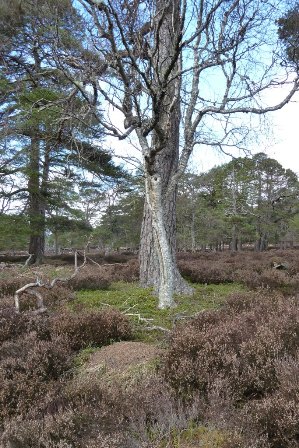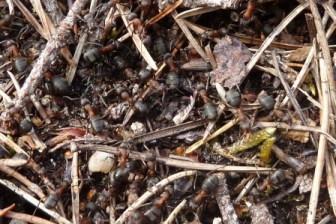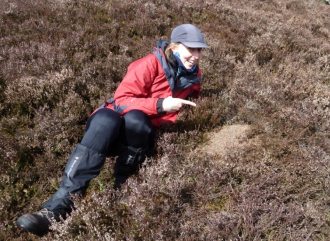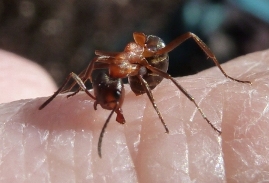Greetings from the Pinewood Patch! I thought it makes sense to have a blog devoted to wood ants as I’m going to be talking about them quite a bit in my blogs so some background info will help you understand my ramblings!
Ants are amazing. I could talk about ants all day! Wood ants are unusual in that they build fantastically sophisticated homes to live in – mounds. All ants have some kind of home that they build to live in, but in the UK only the wood ants have these characteristic mounds and they can reach huge sizes, especially Formica rufa in the south of the UK.
There are 3 “true” species of wood ant – these are Formica rufa (England only), Formica lugubris (northern England and Scotland) and Formica aquilonia (Scotland only). The pic on the right is a Formica aquilonia nest that I saw at Mar Lodge this week (you can just make it own below the pine tree).  Then there are 2 species associated with wood ants which are often called wood ants (rather confusingly) but aren’t “true” wood ants. These are Formica sanguinea (called the slave-making ant) and Formica exsecta (the narrow-headed ant). Formica exsecta is the rarest and is restricted to the Cairngorms, Rannoch and Devon.
Then there are 2 species associated with wood ants which are often called wood ants (rather confusingly) but aren’t “true” wood ants. These are Formica sanguinea (called the slave-making ant) and Formica exsecta (the narrow-headed ant). Formica exsecta is the rarest and is restricted to the Cairngorms, Rannoch and Devon.
The wood ant mound is a marvellous thing – on the surface it looks just like a pile of pine needles and litter, but inside there are intricate tunnels (up to 3 meters deep!) in the mound and surrounding soil. The “thatch” of pine needles/twigs/debris is like an umbrella over the nest and water just trickles away over it, keeping the nest dry. The thatch also acts like a solar panel, keeping the ants warm. Ants can be seen running about and sunbathing on top of the nest on sunny days (see pic below) and pass heat onto their nest-mates deeper inside the nest. Inside the nest is a chamber for the queen and her eggs, a nursery for the larvae, a rubbish dump, a food store and even a graveyard! 
In Scotland, the species your most likely to bump into is Formica aquilonia – this is the most common and is the least “fussy” in terms of habitat, being able to live in shadier forests than the other species. On the other hand, Formica exsecta is much rarer and is very fussy, favouring open, sunny habitat on the edge of the forest. Formica lugubris is inbetween these two in terms of habitat. Formica sanguinea is different again – it doesn’t build mounds but lives under rocks or in cracks in trees and kidnaps the young of other ants to live as slaves in their nests! Wood ants aren’t always found purely in pinewoods – they can be found in birch forest too and Formica exsecta has even been recorded in grassy fields away from woodland! The different species can be tricky to seperate in the field, but with practice it is possible. I can identify Formica exsecta due to its characteristic heart-shaped head, but aquilonia and lugubris require looking at tiny hairs on their faces and bodies so I need more practice with these!
In the UK Formica exsecta makes tiny nests, unlike its relatives, which can reach up to 2m tall! I discovered this week while taking a trip to Mar Lodge to meet my mentor there, Shaila Rao, how difficult they can be to find! Unless you are looking from the right angle, you can walk right past them. A lot of my summer fieldwork will involve locating the nests of this species so I better get my eye in for them! Here is a pic of me with a nest – we had GPS coordinates for it but it took me and Jenni (my James Hutton mentor) a good while to find it, even though it was only metres away! 
Wood ants are an extremely important part of pinewood habitat – they interact with the soil, disperse seeds of rare plants, alter levels of invertebrate herbivores and predators and are food for the capercaille and many other animals that live in the forest. Many believe that wood ants are a sign of a healthy pinewood.
I could happily sit and watch a nest of ants all day, watching what they get up to, but I learned my lesson this week that one can’t spend too long sitting next to a nest! Wood ants are fearless and will defend their nests aggressively – this little Formica exsecta didn’t like me hanging around his nest and he let me know about it! Their bite isn’t painful, though they squirt formic acid too as a defence and some people can have an allergic reaction so be careful when observing these ants. Don’t let this put you off looking for them though (they’re very tame compared to the army ants and fire ants in other parts of the world!)
Well I think I’ve rambled enough for one blog! Remember to keep a look out for wood ants when you’re walking about in pinewoods this summer!
Hayley
Caledonian Pinewood Invertebrates
